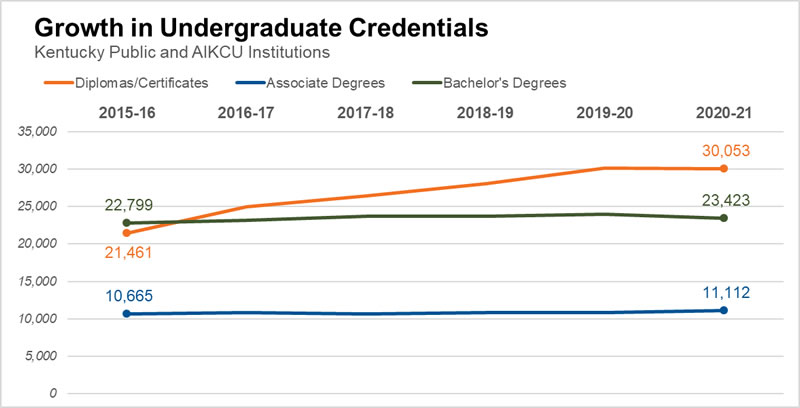Despite COVID-19 pandemic, CPE brief shows Kentucky is on track to reach higher education goals
November 19, 2021

A new brief by Kentucky’s Council on Postsecondary Education shows the number of degrees and credentials awarded in the state remained steady during the first year of the COVID-19 pandemic. The total number of degrees and credentials decreased by just 0.2% in the 2020-21 academic year and have increased by 23.5% since 2015-16.
There were many gains in critical workforce areas, such as an increase in the number of undergraduate degrees among underrepresented minority students as well as the number of students earning undergraduate degrees in STEM+H fields.
This is welcome news to Council President Aaron Thompson, who was quick to praise the campuses for doubling down on efforts to help students cross the finish line during a pandemic.

“The tremendous challenges of the last year and a half have not knocked us off track from our ambitious goals for Kentucky, and that’s really a tribute to the resiliency of Kentucky’s campuses and students,” said Thompson. “It’s an encouraging sign for the future of Kentucky’s workforce as we continue to grapple with, and recover from, the economic effects of the pandemic.”
The brief details the number and types of credentials earned in 2020-21 at Kentucky’s public universities, the campuses of the Association of Independent Kentucky Colleges and Universities, and the Kentucky Community and Technical College System. The annual brief tracks progress toward the state’s goal of raising the percentage of Kentuckians with a high-quality postsecondary credential to 60% by the year 2030.
The brief showed that degrees earned by underrepresented minority students continued to rise. From 2019-20 to 2020-21, degrees awarded to URM students increased by 2.3% overall. In the Kentucky Community and Technical College System, URM student credentials grew faster than the overall total, increasing 4.3% over the previous year and 46.1% since 2015-16.
“It’s an encouraging sign for the future of Kentucky’s workforce as we continue to grapple with, and recover from, the economic effects of the pandemic.” - CPE President Aaron Thompson
Campuses have exceeded the annual target in Kentucky’s five-year strategic agenda for bachelor’s degrees among underrepresented minority students. A total of 3,322 URM students earned a baccalaureate degree during the year, well above the annual goal of 2,938. Those numbers build on years of significant progress; at public universities, URM degrees have increased 25.2% since 2015-16.
“Those are staggering numbers by any measure, but particularly when you look at them compared to other states,” Thompson said. “We are on our way toward closing the educational gaps that are hindering Kentucky’s workforce from reaching its full potential.”
The number of students who received a STEM+H credential in Kentucky was up 2.8% year-over-year, a win for workforce development in Kentucky. Public universities awarded 6,724 STEM degrees last year, surpassing the goal laid out in the state’s strategic plan, “Stronger by Degrees,” which called for at least 6,620 STEM+H degrees to be produced annually by the 2020-21 academic year.
Key findings:
- Total degrees and credentials decreased slightly in 2020-21, falling from 81,482 in 2019-2020 to 81,317, a 0.2% dip. Total degrees and credentials awarded include diplomas, undergraduate certificates, associate degrees, baccalaureate degrees, master’s degrees, specialist degrees, doctoral degrees and postgraduate certificates.
- Total bachelor’s degrees at public and private institutions were down 2.2% in 2020-21. Bachelor’s degree production fell 3.9% at public universities but was up 4.8% at AIKCU institutions.
- Total graduate degrees were down by 0.5% in 2020-21. While graduate degree production at AIKCU institutions decreased 7.3%, public universities increased graduate degree production by 7.1%.
- The number of underrepresented minority students who earned credentials or degrees was up 2.3% in 2020-21. The number of low-income students who earned credentials or degrees was up 4.5% at public institutions in 2019-20, the most recent year available.
The brief is available on the Council's website at http://cpe.ky.gov/data/reports/2021degreesreport.pdf.
Last Updated: 12/8/2021
